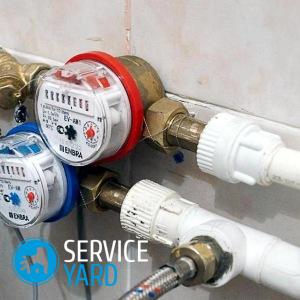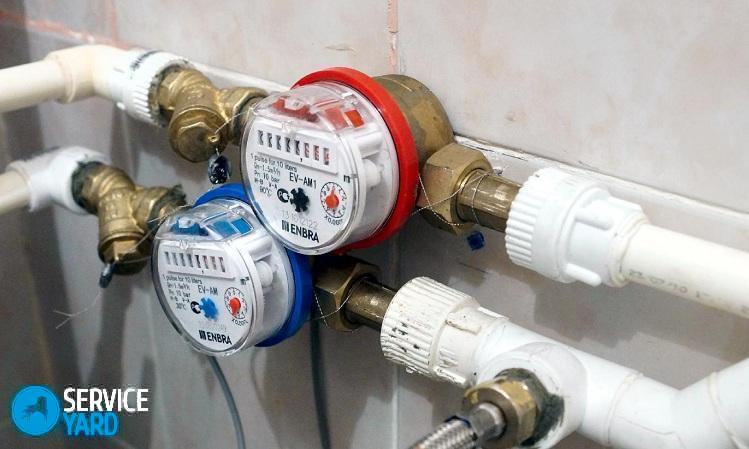Installation of a water meter in a private house

Installation of water metering devices makes it possible to significantly reduce the cost of paying for water supply. They can be installed both in the apartment and in the house or cottage. The installation process is almost identical, there are only a few different nuances - they are associated with subsequent registration and the choice of place for placement. You decide whether to install it yourself or use the services of a specialist. Legislation allows you to install a water meter yourself. It is imperative that the device must be checked and sealed before installation after all work has been completed. If you do not, then the performance of the device will not be taken into account. Below we will consider how the installation of a water meter in a private house takes place, its selection, installation places for it, as well as the appropriateness of this procedure.
to contents ↑Expediency of installation
Very often we come across a list of situations when installing water meters in a private house is economically advantageous:
- If the number of registered and living people is the same, then the savings in paying for the use of water after installing the meter will be about 30 percent.
- It will also be advisable to install it if the water supply to a private house is carried out from centralized water supply networks in order to pay for water supply not according to average indicators that are overstated, but upon the fact of consumption.
- It is also advantageous to install metering devices, because owners of private houses in the summer period are required to pay a lot of money for watering gardens.
to contents ↑Important! It is impractical to install if more people live in the house than registered.
Device selection
Nowadays, there are about 500 varieties of meters.
They are divided into such species.
Tachometric water meters
The flow of water in them passes through the mechanism of the device and acts on the impeller, which is located inside the housing. The impeller rotates and is converted into indicators of water consumption by a counting mechanism.
Such aggregates are wet and dry:
- In wet ones, a mechanism is washed by a stream of water. They are inexpensive, accurate and easy to use, most often used in private homes and apartments to calculate the amount of water used. They are also sensitive to impurities in water.
- The dry type device does not have such a disadvantage. Here, the sensing mechanism is located inside a sealed chamber of non-magnetic material. To read the impeller rotation, two magnetic inserts are installed inside. Such units are more expensive.
Important! For a private house, a wet type tachometer water meter is best suited.
Electromagnetic
The body acts as a coil, and the flow of transported water acts as a core. The volume of water that has passed through the device is calculated by the flow rate, the strength of the created field and the cross section of the pipe.
Important! Such units are accurate, but also expensive, and they are not repaired. They are not used for apartments and private houses.
Ultrasonic
Very reliable and accurate. To determine the flow rate of water, the speed of sound in the forward and opposite directions to the fluid flow in them is compared.
Other classification principles:
- Also, metering devices are divided into volatile and mechanical.
- There are single-jet and multi-jet systems in diameter - it all depends on the place where they will be installed.
Important! When choosing meters, consider the diameter of the pipes on which you will mount them. Most often, 0.5 and 075 inch pipes are used in homes.
- There are both universal models, and those that can be fixed only horizontally or vertically - consider this when choosing.
- Models painted in blue are for cold water, red for hot.
Installation Rules
It is necessary to adhere to all requirements and rules when installing metering devices.
Rules for installing water meters in a private house:
- Choose units that are certified in your country.
- Use coarse filters that are installed upstream of the meter. Less dense particles will enter the device and the device will not fail. The probability of spoilage of the impeller is lower, and the accuracy will be higher when using this filter.
- To prevent the impeller from rotating in the opposite direction, the check valve must be installed.
- In a private house, installation of water meters is necessary in a room where the temperature does not drop below 5 degrees.
- Water meters in a private house are installed on the site inside a specially made well.
Important! The owner is responsible for the part of the pipeline that goes from the installation site of the meters to the house. If a water leak occurs, then the owner will pay the money according to the readings of the counters.
- Invite a representative of the management company to seal the water meters after installing them.
to contents ↑Important! When buying water meters, check to see if they have technical data sheets, and also check the serial numbers on the case with the numbers from the documents.
Installation of a water meter
Installation of a water meter in a private house in a special well is as follows:
- Dig a hole 1.2 * 1.2 * 1.0 m in size under the well.
Important! Parameters in different regions may vary, so check with the representatives of the water utility for this information.
- Add to the dimensions of the pit another 25-30 cm on each side to make brickwork for its strength and insulation.
- To do the work more conveniently, go deep another 10 cm in the place where there is a branch from the central water supply to your home.
- Level the bottom of the pit. Make a concrete base for masonry walls or use cinder concrete.
- After the base has dried, lay the walls.
- Spread several rows of bricks to the level of the pipeline.
- Insert a stopcock into the pipeline - it must be installed in front of the meter.
- Install a coarse water filter, then a water meter, then a check valve.
Important! The non-return valve is not needed in all cases. Read in the instructions if it is necessary when installing your unit.
- Connect the pipe using the end fitting.
- The counter is installed. Finish masonry.
- Insulate the outer surface using heat-insulating materials - polystyrene foam, polystyrene foam.
- Fill the space between the walls of the pit and the brick with earth.
- Invite a water utility representative to seal the meter.
- Install the cover on the well made.
Stock footage
Installing a water meter in a private house is practically no different from installing it in an apartment. The difference lies in the preparation of the installation site, as well as the fact that only one cold water meter is being installed. The latter occurs because mainly in private houses, heating is carried out inside the house, and only a pipe with cold water enters the building. It’s up to you to choose whether to install it yourself or turn to specialists for help.
- How to choose a vacuum cleaner taking into account the characteristics of the house and coatings?
- What to look for when choosing a water delivery
- How to quickly create comfort at home - tips for housewives
- How to choose the perfect TV - useful tips
- What to look for when choosing blinds
- What should be running shoes?
- What useful things can you buy in a hardware store
- Iphone 11 pro max review
- Than iPhone is better than Android smartphones




